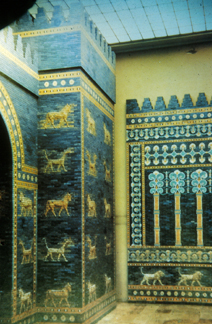
Ishtar Gate, reconstructed entrance to the city of Babylon,
on display in the State Museum of Berlin
575 BCE
ART 198 - HISTORY OF WORLD CERAMICS
| Built by Nebuchadnezzar II, the Ishtar Gate was one of the main entries to the city of Bablyon, capital of the Babylonian Empire. The arched gate at the left was made of brick glazed with a copper turquoise glaze alternating with unglazed brick covered with gold leaf. Lions, bulls, and dragons stride along in rows flanking the entrance. The top is crenelated (notched), and would have provided cover for archers defending the city entrances. At the right is another panel, this one from the throne room of the palace of Nebuchadnezzar II, mentioned in the Bible. On the throne room panel, lions are arranged in a frieze below a row of stylized palms. These reconstructed fragments of the Ishtar Gate are all that remain of Bablyon. The Hanging Gardens and the Ziggurat of Marduk exist only in written descriptions. The use of glazed brick and tile in architecture is a recurrent theme in building of the Middle East, and we will see it again later in places as far away as the mosques and madrasas of Samarqand and the Nazarid Palaces of Granada, Spain. | Ishtar Gate, reconstructed entrance to the city of Babylon, on display in the State Museum of Berlin 575 BCE |
|
|